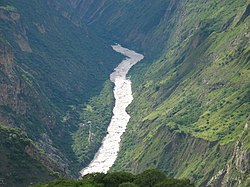Apúrimac River
| Apurímac River | |
| Country | Peru |
|---|---|
| Regions | Apurímac Region, Cusco Region |
| Tributaries | |
| - left | Qañawimayu |
| - right | Hatun Wayq'u, Aqumayu |
| Source | Mismi |
| - coordinates | 15°31′31″S 71°41′27″W / 15.52528°S 71.69083°W |
| Mouth | Ene River |
| - coordinates | 12°15′46″S 73°58′44″W / 12.26278°S 73.97889°WCoordinates: 12°15′46″S 73°58′44″W / 12.26278°S 73.97889°W |
| Length | 850 km (528 mi) |
|
Amazon Basin with Apurímac River highlighted (lower left)
|
|
The Apurímac River (Spanish: Río Apurímac, IPA: [ˈri.o apuˈɾimak]; from Quechua apu 'divinity' and rimaq 'oracle, talker') rises from glacial meltwater of the ridge of the Mismi, a 5,597-metre-high (18,363 ft) mountain in the Arequipa Province in southern Peru.
The Apurímac is a source of the world's largest river system, the Amazon River. It rises in the south-western mountain ranges of Peru, 10 km (6.2 mi) from the village Caylloma, and less than 160 km (99 mi) from the Pacific coast.
It flows generally northwest past Cusco in narrow gorges of up to 3,000 m, twice as deep as the Grand Canyon in the United States, its course interrupted by falls and rapids. Of the six attempts so far to travel the Apurímac in its full length, only two have been successful.
After 730.70 kilometres (454.04 mi), the Apurímac joins the Mantaro River and becomes the Ene River at 12°15′46″S 73°58′44″W / 12.26278°S 73.97889°W, 440 m (1,440 ft) above sea level; then after joining the Perené River at 330 m (1,080 ft) above sea level, it becomes the Tambo River; when it joins the Urubamba at 280 m (920 ft) above sea level the river becomes the Ucayali, which is the main headstream of the Amazon.
...
Wikipedia


